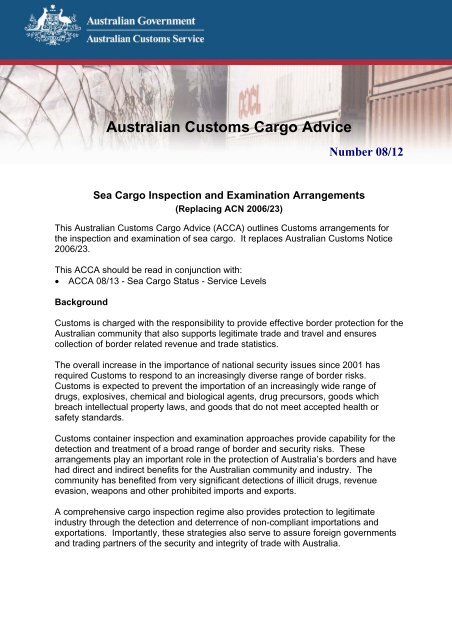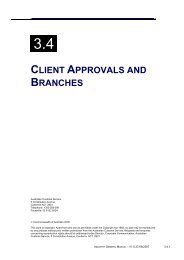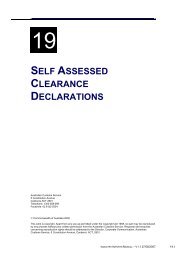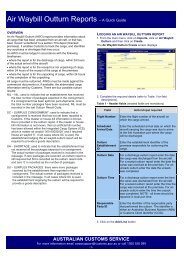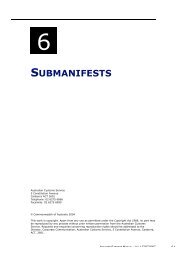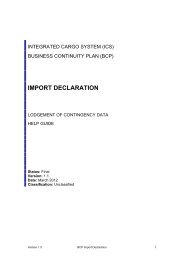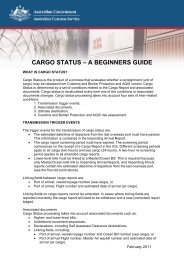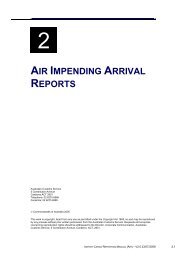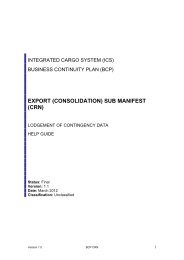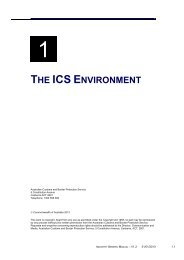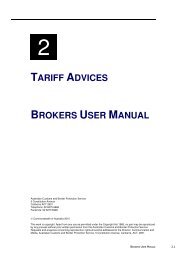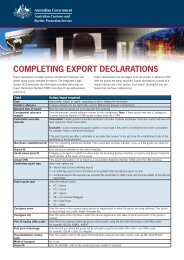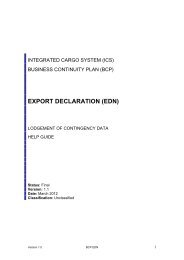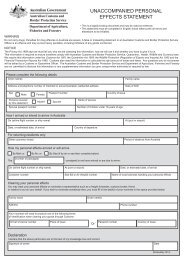Sea Cargo Inspection and Examination Arrangements - Australian ...
Sea Cargo Inspection and Examination Arrangements - Australian ...
Sea Cargo Inspection and Examination Arrangements - Australian ...
You also want an ePaper? Increase the reach of your titles
YUMPU automatically turns print PDFs into web optimized ePapers that Google loves.
<strong>Australian</strong> Customs <strong>Cargo</strong> Advice<br />
Number 08/12<br />
<strong>Sea</strong> <strong>Cargo</strong> <strong>Inspection</strong> <strong>and</strong> <strong>Examination</strong> <strong>Arrangements</strong><br />
(Replacing ACN 2006/23)<br />
This <strong>Australian</strong> Customs <strong>Cargo</strong> Advice (ACCA) outlines Customs arrangements for<br />
the inspection <strong>and</strong> examination of sea cargo. It replaces <strong>Australian</strong> Customs Notice<br />
2006/23.<br />
This ACCA should be read in conjunction with:<br />
• ACCA 08/13 - <strong>Sea</strong> <strong>Cargo</strong> Status - Service Levels<br />
Background<br />
Customs is charged with the responsibility to provide effective border protection for the<br />
<strong>Australian</strong> community that also supports legitimate trade <strong>and</strong> travel <strong>and</strong> ensures<br />
collection of border related revenue <strong>and</strong> trade statistics.<br />
The overall increase in the importance of national security issues since 2001 has<br />
required Customs to respond to an increasingly diverse range of border risks.<br />
Customs is expected to prevent the importation of an increasingly wide range of<br />
drugs, explosives, chemical <strong>and</strong> biological agents, drug precursors, goods which<br />
breach intellectual property laws, <strong>and</strong> goods that do not meet accepted health or<br />
safety st<strong>and</strong>ards.<br />
Customs container inspection <strong>and</strong> examination approaches provide capability for the<br />
detection <strong>and</strong> treatment of a broad range of border <strong>and</strong> security risks. These<br />
arrangements play an important role in the protection of Australia’s borders <strong>and</strong> have<br />
had direct <strong>and</strong> indirect benefits for the <strong>Australian</strong> community <strong>and</strong> industry. The<br />
community has benefited from very significant detections of illicit drugs, revenue<br />
evasion, weapons <strong>and</strong> other prohibited imports <strong>and</strong> exports.<br />
A comprehensive cargo inspection regime also provides protection to legitimate<br />
industry through the detection <strong>and</strong> deterrence of non-compliant importations <strong>and</strong><br />
exportations. Importantly, these strategies also serve to assure foreign governments<br />
<strong>and</strong> trading partners of the security <strong>and</strong> integrity of trade with Australia.
<strong>Inspection</strong> <strong>and</strong> <strong>Examination</strong> Facility Locations <strong>and</strong> Operating Hours<br />
Customs operates Container <strong>Examination</strong> Facilities (CEFs) near Australia’s largest<br />
container terminals in Melbourne, Sydney, Brisbane, Fremantle <strong>and</strong> Adelaide.<br />
The hours of operation of the CEFs in Melbourne, Sydney, Brisbane <strong>and</strong> Fremantle<br />
vary to cater for local operational issues, however, in general they operate 0600 to<br />
2230 between Monday <strong>and</strong> Friday <strong>and</strong> 0600 to 1430 on Saturdays. The Adelaide<br />
CEF operates from 0730 to 1630 on Monday to Friday.<br />
In addition to CEF operations, cargo is also subject to examination by Customs at<br />
other ports around Australia.<br />
Volume of <strong>Cargo</strong> Selected for Customs Intervention<br />
In the 2008/09 financial year, Customs target is to inspect 134,000 twenty foot<br />
equivalent units (TEU) <strong>and</strong> examine 14,300 TEU nationally.<br />
Selection of <strong>Cargo</strong> for Customs Intervention<br />
All sea cargo entering Australia is risk assessed, <strong>and</strong> where appropriate, Customs<br />
conducts further intervention on the cargo.<br />
ACCA 08/13 - <strong>Sea</strong> <strong>Cargo</strong> Status - Service Levels outlines the information that<br />
Customs requires before it can finalise its risk assessment for sea cargo, the<br />
timeframes that Customs aims to complete its risk assessment within, once all<br />
required information is available, <strong>and</strong> the services that Customs offer when those<br />
timeframes cannot be met. It also provides information on ways in which industry can<br />
assist Customs to minimise its impact on the sea cargo supply chain.<br />
Importers <strong>and</strong> exporters need to ensure they make provision in their reporting <strong>and</strong><br />
logistics arrangements for the possibility of Customs selecting their cargo for<br />
intervention.<br />
Costs <strong>and</strong> Charges<br />
Section 186 of the Customs Act 1901 provides Customs with the power to examine<br />
any goods subject to its control. It has been determined that section 186 applies to<br />
the CEF logistics arrangements. The cost of presenting cargo for examination at the<br />
CEF is being recovered through the Import Processing Charge.<br />
As advised in <strong>Australian</strong> Customs Notice 2006/21 the current Import Processing<br />
Charges for sea cargo are:<br />
Item<br />
Electronic Import Declarations for goods<br />
imported by sea<br />
Documentary Import Declarations for goods<br />
imported by sea<br />
Current charge<br />
$50.00 (GST exempt)<br />
$65.75 (GST exempt)
Damages<br />
Section 34 of the Customs Act provides that:<br />
Customs shall not be liable for any loss or damage occasioned to any goods<br />
subject to the control of Customs except by the neglect or wilful act of some<br />
officer.<br />
While Customs exercises appropriate care for all cargo, importers <strong>and</strong> exporters<br />
should ensure that they arrange for the appropriate packing <strong>and</strong> insurance of their<br />
goods. Customs policy in regard to damages can be downloaded from Customs<br />
internet site at<br />
http://www.customs.gov.au/webdata/resources/files/CEFdamagesPolicy.pdf<br />
Contacting Customs<br />
All queries about matters addressed in this ACCA should be directed to the<br />
Customs Information <strong>and</strong> Support Centre (CI&SC) by:<br />
• telephone on 1300 558 099<br />
• facsimile on (02) 8337 6713<br />
• email at cargosupport@customs.gov.au<br />
CI&SC staff members will not provide information about specific consignments unless<br />
there are special circumstances, for example time-critical or hazardous consignments.<br />
Making a complaint or offering a compliment<br />
Customs recognises the public’s right to comment on its services <strong>and</strong> is interested in<br />
what any person has to say.<br />
To comment on any aspect of our service, anyone can;<br />
• Speak to a Customs officer<br />
• Complete a reply paid comment sheet, available at Customs offices<br />
• Write to the Complaints <strong>and</strong> Compliments Network, free of charge<br />
Complaints <strong>and</strong> Compliments<br />
<strong>Australian</strong> Customs Service<br />
GPO 9834<br />
In your capital city<br />
• Contact the Complaints <strong>and</strong> Compliments Network on 1800 228 227 or via email at<br />
comments@customs.gov.au<br />
When making a complaint related to sea cargo, all available shipping <strong>and</strong> cargo<br />
information should be included.<br />
Complaints will be fully investigated <strong>and</strong> Customs will aim to respond to the<br />
complainant within 15 business days of receiving the complaint.<br />
Jaclyne Fisher<br />
National Director<br />
<strong>Cargo</strong> Division<br />
10 October 2008


